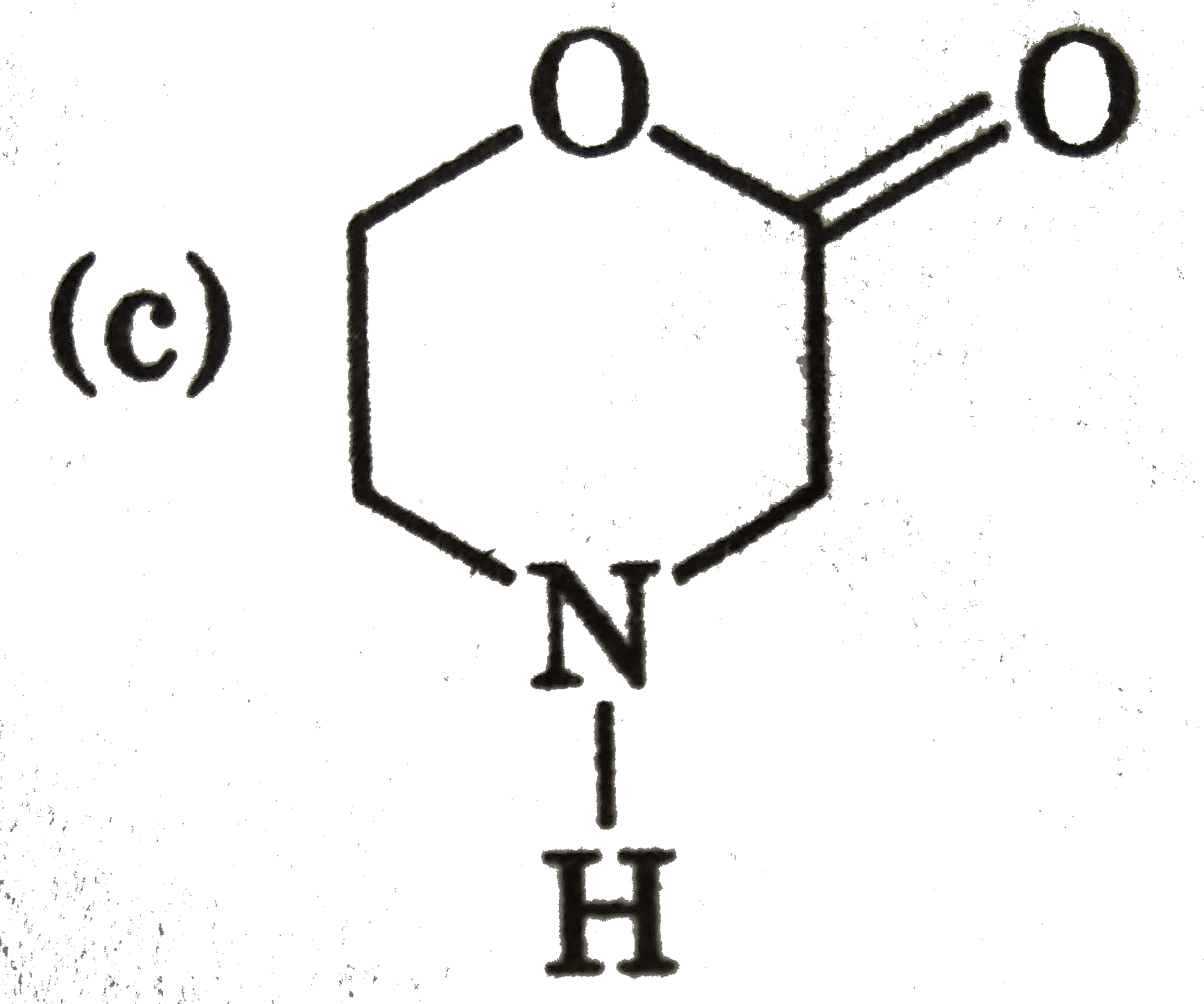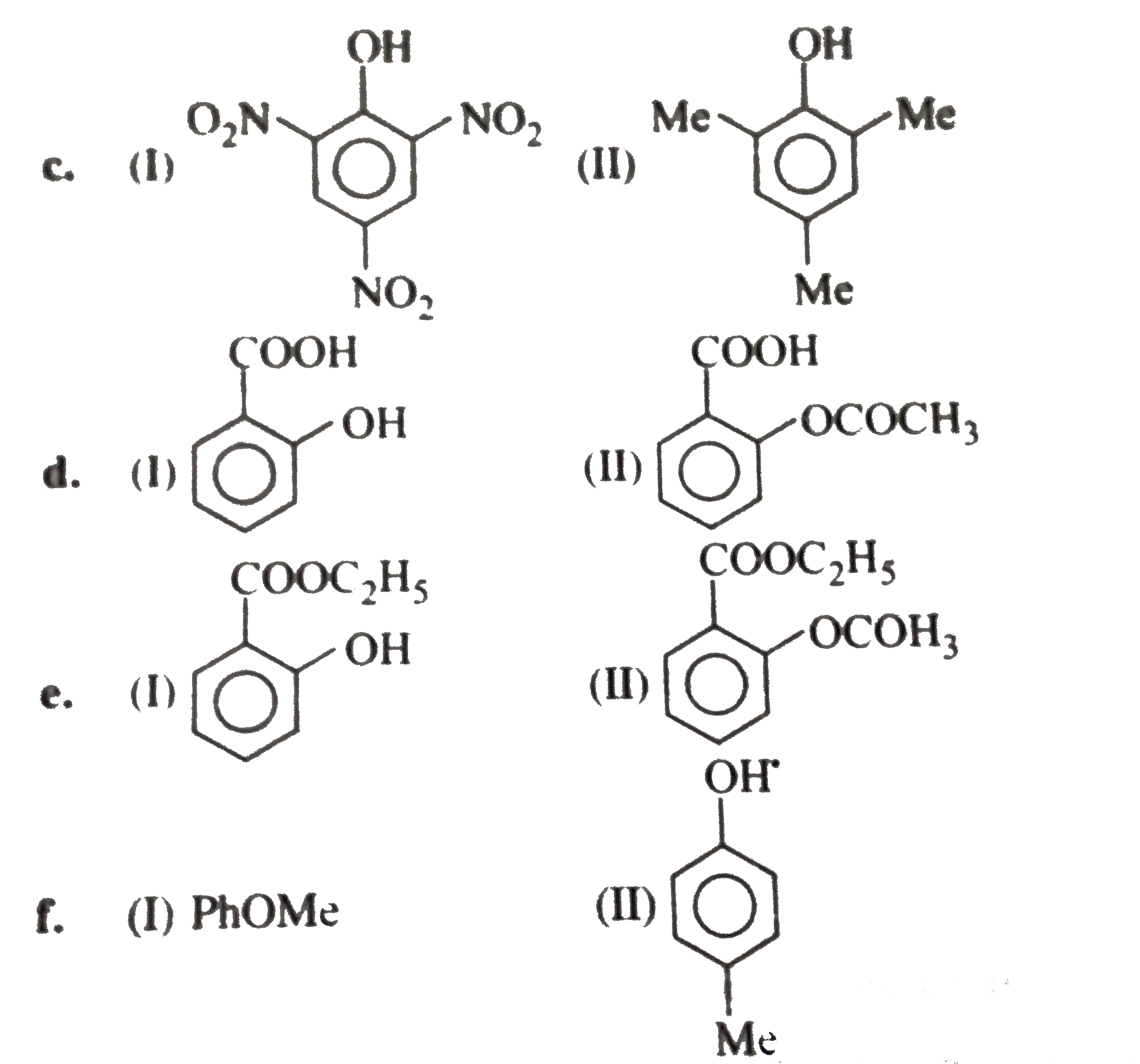Distinguish between the following pairs:
((I),,.(II)),(a.(PhNH3)+2SO2−4,and,![Distinguish between the following pairs: {:((I),,.(II)),(a.(PhNH(3))(2)^(+)SO(4)^(2-),and,,(b.Me(4)N^(o+)CI^(Theta),and,[Me(3)overset(o+)NH]CI^(Theta)),(c.PhNMe(2),and,PHNHMe),(d.Me(2)N-CH(2)OH,and,Me(4)overset(o+)Noverset(Theta)OH),(e.Phoverset(o+)(NH(3))CI^(Theta),and,(f.PhNH(2),and,(g.PhNHCOMe,and,PhNH(2)):}](https://d10lpgp6xz60nq.cloudfront.net/physics_images/KSV_CHM_ORG_P2_C15_S01_026_Q01.png) ,(b.Me4N⊕CIΘ,and,[Me3⊕NH]CIΘ),(c.PhNMe2,and,PHNHMe),(d.Me2N−CH2OH,and,Me4⊕NΘOH),(e.Ph⊕NH3CIΘ,and,(f.PhNH2,and,(g.PhNHCOMe,and,PhNH2):}
,(b.Me4N⊕CIΘ,and,[Me3⊕NH]CIΘ),(c.PhNMe2,and,PHNHMe),(d.Me2N−CH2OH,and,Me4⊕NΘOH),(e.Ph⊕NH3CIΘ,and,(f.PhNH2,and,(g.PhNHCOMe,and,PhNH2):}
Text Solution
(a) Add BaCl2 solution (I) is a sulphate salt and will give a white precipitate of BaSO4. (II) is sulphonate (sulphonic acid salt) and will not give any precipitate.
(b) Add concentrated NaOH and heat the mixture. (II) will change to a volatile free base Me3N, which has a typical NH3 odour. compound (I) will not react.
(c) With HNO2(NaNO2+HCl),(II) (2∘ amine) will give yellow oil of nitrosamine, which is insoluble in acid. (I) will react with HNO2 to give p-nitro compound which is still basic and is soluble in acid.

(II) is ionic and thus gives white precipitate of Ba(OH)2 on addition of BaCl2 solution. it is a strong base and its solution turns red litmus blue.
(I) is a covalent amino alcohol and does not respond to the above tests.
(e) (I) is ionic and gives white precipate of AgCl with AgNO3 solution whereas (II) does not.
(f) (I) is 1∘ aromatic amine and gives dye test, whereas (II) does not.
(g) (II) is basic and (I) (amide) is amphoteric, so (II) dissolves in aqueous HCl, whereas (I) Does not.
|
Topper's Solved these Questions
- ORGANIC COMPOUNDS WITH FUNCTIONAL GROUPBOOK - CENGAGE CHEMISTRYCHAPTER - ORGANIC COMPOUNDS WITH FUNCTIONAL GROUPEXERCISE - Exercises Subjective
21 Videos
- ORGANIC COMPOUNDS WITH FUNCTIONAL GROUPBOOK - CENGAGE CHEMISTRYCHAPTER - ORGANIC COMPOUNDS WITH FUNCTIONAL GROUPEXERCISE - Exercises Concept Application
13 Videos
- ORGANIC COMPOUNDS WITH FUNCTIONAL GROUPBOOK - CENGAGE CHEMISTRYCHAPTER - ORGANIC COMPOUNDS WITH FUNCTIONAL GROUPEXERCISE - Archives Analytical And Descriptive
24 Videos
- NUCLEAR CHEMISTRYBOOK - CENGAGE CHEMISTRYCHAPTER - NUCLEAR CHEMISTRYEXERCISE - Archives Subjective
13 Videos
- P-BLOCK GROUP 15 ELEMENTS - THE NITROGEN FAMILYBOOK - CENGAGE CHEMISTRYCHAPTER - P-BLOCK GROUP 15 ELEMENTS - THE NITROGEN FAMILYEXERCISE - Exercises Archives (Subjective)
28 Videos
Similar Questions
Knowledge Check
Me−O∣∣C−O−CH2−CH2−⊕NH2NaOH−−−→Q
AMe−O∣∣C−O−CH2−CH2−NH2BMe−O∣∣C−NH−CH2−CH2−OHC DMeCOONa+HOCH2CH2NH2
DMeCOONa+HOCH2CH2NH2In the reaction :
Me3C−O−CH2CH3+HI1 moleΔ−−→AMe3C−OH+CH3CH2IBMe3C−I+CH3CH2OHCMe3C−I+CH3CH2IDMe3C−OH+CH3CH2OHIn the reaction
Me3NBrCN−−−→A(i)H2O−−−−→(ii)ΔB
B isAMeNH2BMe3NOCMe2NHDMe2NCOOH
Complete and blance the following reactions:
i. HNO3+HCI→NO+CI2
ii. Ce3++S2O2−8→SO2−4+Ce4−
iii. CI2+OHΘ→CIΘ+CIOΘ
View SolutionComplete and blance the following reactions:
i. HNO3+HCI→NO+CI2
ii. Ce3++S2O2−8→SO2−4+Ce4−
iii. CI2+OHΘ→CIΘ+CIOΘ
View SolutionIn the reaction:
Me3C−O−CH2CH3+HI1 moleΔ−−→
View SolutionIn the reaction:
Me3C−O−CH2CH3+HI1 moleΔ−−→
View SolutionMe−CH2−CH2OHKMnO4/H+−−−−−−−−→(A)RedP+Br2−−−−−−→(B)NH3−−−−−→(excess)(C)
Then :
View Solution

